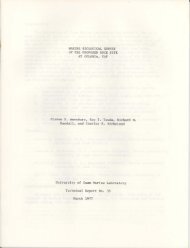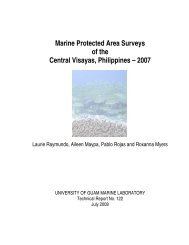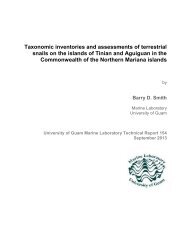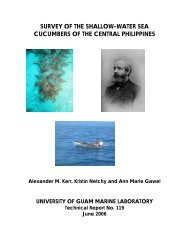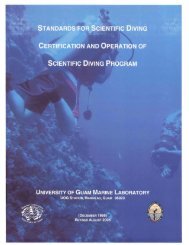Growth of the rabbitfish Siganus randalli Woodland - University of ...
Growth of the rabbitfish Siganus randalli Woodland - University of ...
Growth of the rabbitfish Siganus randalli Woodland - University of ...
- No tags were found...
You also want an ePaper? Increase the reach of your titles
YUMPU automatically turns print PDFs into web optimized ePapers that Google loves.
For <strong>the</strong> full data set, <strong>the</strong> differences in variances between tanks were not significant forstandard length, but <strong>the</strong>y were for weight. We made several attempts to transform <strong>the</strong> weightdata to achieve homogeneity <strong>of</strong> <strong>the</strong> variances but were not successful. Because <strong>of</strong> this, westatistically analyzed only <strong>the</strong> data for standard lengths in this trial.However, for <strong>the</strong> data set obtained by randomly selecting 15 records, we found <strong>the</strong>assumptions <strong>of</strong> homogeneity <strong>of</strong> variance to be valid for both weight and length. In this case,we used <strong>the</strong> data on fish weights for statistical comparisons.Comparison <strong>of</strong> feeding ratesYTo determine an optimal feeding rate, we compared <strong>the</strong> growth <strong>of</strong> groups <strong>of</strong> 15juvenile <strong>Siganus</strong> <strong>randalli</strong> fed with commercial catfish feed at rates <strong>of</strong> ei<strong>the</strong>r 3, 6, or 12% <strong>of</strong>fish weight per day. Each <strong>of</strong> nine groups <strong>of</strong> fifteen fish was held in a separate 2-ton tanksupplied with constantly flowing seawater. The tanks were randomly assigned to one <strong>of</strong> <strong>the</strong>treatments until each treatment had been assigned three tanks. The duration <strong>of</strong> <strong>the</strong> growthtrial was 28 days. The ranges <strong>of</strong> dissolved 0" pH, and temperature over <strong>the</strong> duration <strong>of</strong> <strong>the</strong>growth trial are presented in Table 4. The mean weights <strong>of</strong> <strong>the</strong> fish in each tank at <strong>the</strong>beginning <strong>of</strong> <strong>the</strong> growth trial were compared by one-way ANOV A to verify that <strong>the</strong>re wereno significant differences between tanks at <strong>the</strong> onset <strong>of</strong> <strong>the</strong> experiment. At <strong>the</strong> end <strong>of</strong> <strong>the</strong>trial, 10 fish from each tank were randomly selected and weighed to assure a balanced designfor <strong>the</strong> ANOV A model used. A mixed-model ANOV A (BMDP 8V) was used to compare <strong>the</strong>final weights between treatment groups. In <strong>the</strong> model, <strong>the</strong> treatment, or feeding rate, wasconsidered a fixed factor and <strong>the</strong> tank was considered a random factor. We used a nestedANOV A model with tanks nested in <strong>the</strong> treatment groups and <strong>the</strong> fish nested in tanks. Priorto <strong>the</strong> ANOV A we used Levene's Test to verify variance homogeneity.fish asSpecific growth rates, expressed as percent per day, were calculated for each tank <strong>of</strong>100 [ (where W f represents <strong>the</strong> final weight and W o' <strong>the</strong> initial weight. The data were also used tocalculate apparent feed conversion ratios - <strong>the</strong> ratio <strong>of</strong> <strong>the</strong> dry weight <strong>of</strong> <strong>the</strong> food to <strong>the</strong> wetweight <strong>of</strong> <strong>the</strong> increase in fish biomass in each tank. The moisture content <strong>of</strong> <strong>the</strong> food wasdetermined by drying samples to constant weight at 50°C in a drying oven.Comparison <strong>of</strong> feeding freguencyWe compared <strong>the</strong> growth <strong>of</strong> groups <strong>of</strong> juvenile siganids fed ei<strong>the</strong>r I, 2, or 3 times perday in a 28-day growth trial. Nine groups <strong>of</strong> 15 juvenile siganids were each fed withcommercial catfish feed at 12% <strong>of</strong> <strong>the</strong>ir body weight per day. Each <strong>of</strong> nine 2-ton tankssupplied with constantly flowing seawater was randomly assigned to one <strong>of</strong> <strong>the</strong> treatment9





